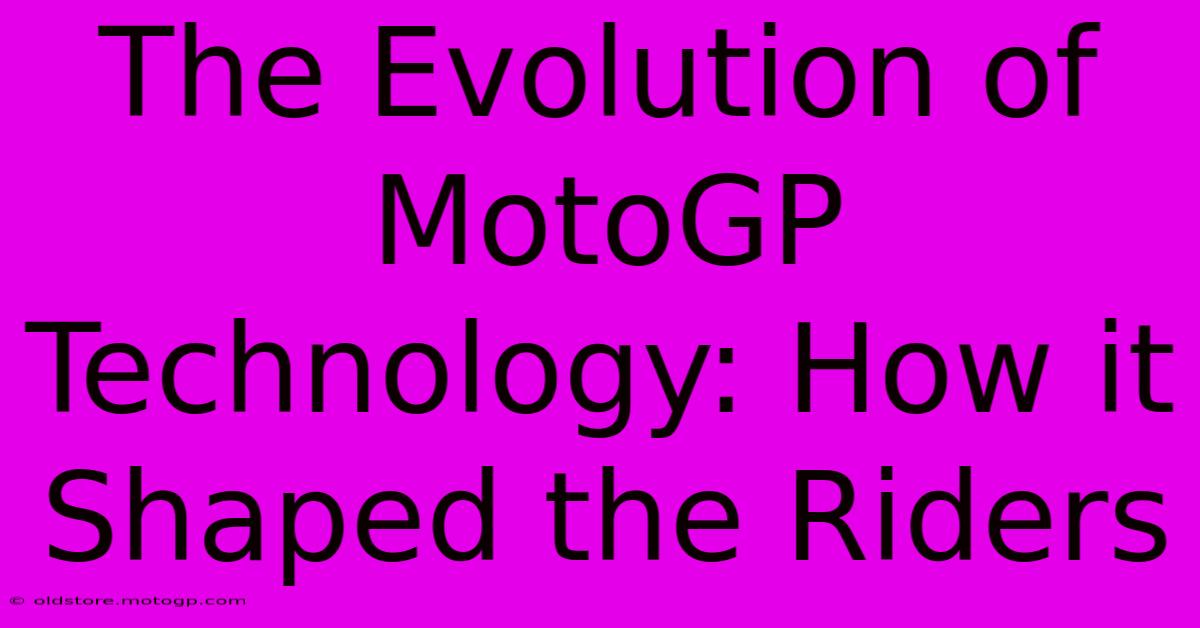The Evolution Of MotoGP Technology: How It Shaped The Riders

Table of Contents
The Evolution of MotoGP Technology: How it Shaped the Riders
MotoGP, the pinnacle of motorcycle road racing, is a relentless pursuit of speed and precision. But the blistering pace isn't solely down to the riders' skill; it's a testament to the extraordinary evolution of technology. From humble beginnings, MotoGP bikes have transformed into sophisticated machines, fundamentally altering the demands and skills required of the riders. This article delves into the key technological advancements and how they've shaped the modern MotoGP rider.
The Dawn of Electronics: A Shift in Riding Style
The early days of MotoGP were dominated by raw power and mechanical skill. Riders wrestled with heavy, less responsive machines, demanding brute strength and fearless control. However, the introduction of electronic rider aids marked a significant turning point.
Early Electronic Interventions:
- Traction control: Initially rudimentary, early traction control systems offered basic intervention, preventing wheel spin. This allowed riders to push harder on the throttle out of corners, reducing the need for incredibly delicate throttle management.
- Anti-wheelie: Similarly, anti-wheelie systems prevented the front wheel from lifting, maintaining stability and improving acceleration. This reduced the physical strain on riders, enabling more consistent lap times.
These early systems significantly changed the rider's role. Instead of constantly battling the machine, they could focus more on line selection and racecraft.
The Age of Sophistication: Seamless Integration and Data Analysis
Modern MotoGP technology represents a quantum leap. Sophisticated electronics are seamlessly integrated, allowing for unparalleled levels of control and data analysis.
Advanced Rider Aids:
- Engine braking control: This precisely manages engine braking, preventing rear-wheel lock-ups under heavy braking and facilitating smoother corner entry.
- Launch control: Optimizes acceleration off the starting line, reducing wheelspin and ensuring maximum traction.
- Cornering ABS: Advanced anti-lock braking systems allow for hard braking while cornering, shortening braking distances and improving corner speeds.
- Pit-lane speed limiter: Ensures adherence to speed limits in pit lane, avoiding penalties.
Data Acquisition and Analysis:
Telematics and data loggers provide riders and engineers with an unprecedented level of detail regarding bike performance and rider input. This allows for precise adjustments to bike setup, maximizing performance and optimizing rider comfort. This data-driven approach is now integral to the success of any MotoGP team.
This sophistication means modern MotoGP riders need different skills. They are less focused on raw physical strength and more on data interpretation, strategic race management, and the ability to seamlessly adapt to various electronic settings.
The Human Element: Still Crucial
Despite technological advancements, the human element remains paramount. The best MotoGP riders possess a unique blend of physical fitness, mental fortitude, and refined riding technique.
Physical Demands:
While technology has lessened some physical demands, the intense G-forces, vibrations, and physical exertion remain significant. Riders undergo rigorous physical training to withstand these pressures and maintain peak performance.
Mental Fortitude:
MotoGP is a high-pressure environment demanding immense concentration and mental resilience. Riders must make split-second decisions, react to changing conditions, and handle the immense pressure of competition.
Adaptability and Precision:
The increasing complexity of MotoGP bikes requires riders to be adaptable and precise. They must master the numerous electronic settings, understand the feedback from the machine, and adjust their riding style accordingly.
Conclusion: A Symbiotic Relationship
The evolution of MotoGP technology hasn't replaced the rider; it's enhanced their capabilities. The relationship between rider and machine is now a symbiotic one, with technology amplifying human skill and pushing the boundaries of what's possible. As technology continues to advance, the demands on MotoGP riders will evolve further, requiring an ever-increasing level of skill, adaptability, and precision. The future of MotoGP will undoubtedly be shaped by this ongoing technological arms race, always pushing the limits of both man and machine.

Thank you for visiting our website wich cover about The Evolution Of MotoGP Technology: How It Shaped The Riders. We hope the information provided has been useful to you. Feel free to contact us if you have any questions or need further assistance. See you next time and dont miss to bookmark.
Featured Posts
-
Become A Legend Racing Motorcycles For Sale
Feb 19, 2025
-
The Role Of Aerodynamics In Moto Gp Cornering
Feb 19, 2025
-
Moto Gp Horsepower Its More Than You Think
Feb 19, 2025
-
How Moto Gp Bikes Achieve Breathtaking Speeds
Feb 19, 2025
-
Yamaha V4 Moto Gp The Champions Choice
Feb 19, 2025
